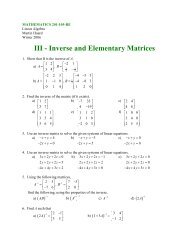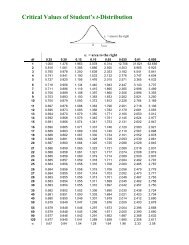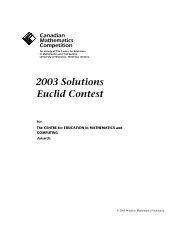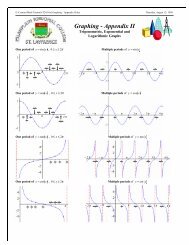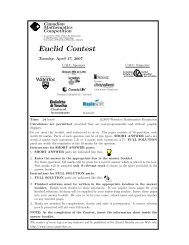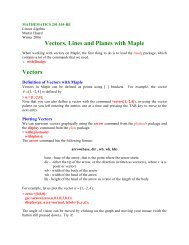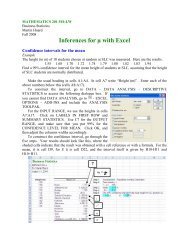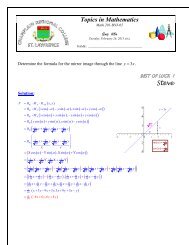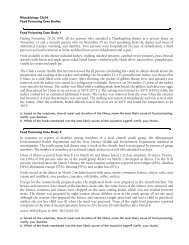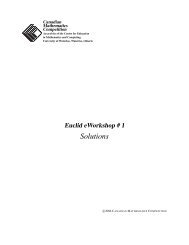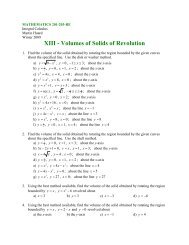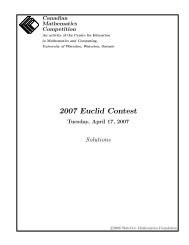Solutions - SLC Home Page
Solutions - SLC Home Page
Solutions - SLC Home Page
You also want an ePaper? Increase the reach of your titles
YUMPU automatically turns print PDFs into web optimized ePapers that Google loves.
Math 105<br />
Semester Review - <strong>Solutions</strong><br />
<br />
2. ku = ( kx1, ky1,<br />
kz1)<br />
∈W<br />
f) ( )<br />
<br />
No. If = ( 4,0,0)<br />
∈<br />
<br />
then ku ( 0,0,0)<br />
{ , , :2 3 8 0, , , }<br />
2 kx − 3 ky + kz = k 2x − 3y + z = k0=<br />
0<br />
since ( ) ( ) ( )<br />
W= xyz x− y+ z− = xyz∈ V<br />
u W and k = 0 ,<br />
= ∉W<br />
since<br />
Geometrically, W is the plane 2x− 3y+ z = 8.<br />
{ }<br />
g) W = ( a,3a− 4, a+ 1 ):<br />
a∈<br />
<br />
No. If u = ( 1, −1, 2)<br />
∈W<br />
<br />
then ku ( 0,0,0)<br />
and<br />
= ∉W<br />
3<br />
V = <br />
k = 0 ,<br />
since if<br />
1 1 1 1 1 1<br />
3<br />
= <br />
20 ⋅ −30 ⋅ + 0−8≠<br />
0<br />
( 0,0,0 ) ( a,3a 4, a 1)<br />
= − + , then<br />
4<br />
we have a = 0, a= and a =− 1 which is impossible.<br />
3<br />
22. For each of the subsets W in ,<br />
i) Find a basis for W.<br />
ii) Find the dimension of W<br />
iii) Give a geometrical interpretation of W.<br />
W = 2 a+ b, a, a−2 b : a,<br />
b∈<br />
{ }<br />
a) ( )<br />
Since ( 2 a+ b, a, a− 2b) = a( 2,1,1) + b( 1,0, − 2)<br />
Then if B = ( 2,1,1 ), ( 1, 0. − 2 we have W span ( B)<br />
{ )}<br />
3<br />
= .<br />
Since B is linearly independent (the two vectors are not multiples of each other)<br />
then B is a basis for W.<br />
dim W = 2<br />
( )<br />
i j k<br />
<br />
n = × − = = − −<br />
( 2,1,1) ( 1,0, 2) 2 1 1 ( 2,5, 1)<br />
1 0 −2<br />
Ergo, W is the plane π :2x− 5y+ z = 0.<br />
{ }<br />
b) W= ( a− 2b+ 3 c,3a+ b+ 2 ca , + 4b−3 c)<br />
: abc , , ∈<br />
Since ( a b c a b c a b c) a( ) b( ) c(<br />
then if B = {( 1,3,1 ),( −2,1, 4 ),( 3, 2, − 3)<br />
} we have W = span ( B)<br />
c ( 1,3,1) + c ( − 2,1, 4) + c ( 3, 2, − 3) = ( 0, 0, 0)<br />
If<br />
− 2 + 3 ,3 + + 2 , + 4 − 3 = 1,3,1 + − 2,1, 4 + 3, 2, − 3)<br />
1 2 3<br />
⎡1 −2 3 0⎤ ⎡1 −2 3 0⎤<br />
⎢ 2 2<br />
3<br />
1<br />
3 1 2 0<br />
⎥R →R − R ⎢<br />
0 7 −7 0<br />
⎥<br />
⎢ ⎥R3 →R3−R<br />
⎢<br />
⎥<br />
1<br />
⎢1 4 −3 0⎥<br />
⎣ ⎦ ⎢⎣0 6 −6 0⎥⎦<br />
⎡1 −2 3 0⎤<br />
⎡1 −2 3 0⎤<br />
R3 →7R3−6R<br />
⎢<br />
1<br />
0 7 −7 0<br />
⎥ 1<br />
⎢<br />
⎥<br />
R2 7<br />
R<br />
⎢<br />
2<br />
0 1 1 0<br />
⎥<br />
<br />
→<br />
⎢<br />
−<br />
⎥<br />
⎢⎣<br />
0 0 0 0⎥⎦<br />
⎢⎣<br />
0 0 0 0⎥⎦<br />
1, then 3, 2, − 3 = 1,3,1 − − 2,1, 4<br />
t = ( ) ( ) ( )<br />
c<br />
c<br />
c<br />
3<br />
2<br />
1<br />
= t<br />
= t<br />
= −t<br />
Winter 2006 Martin Huard 20



